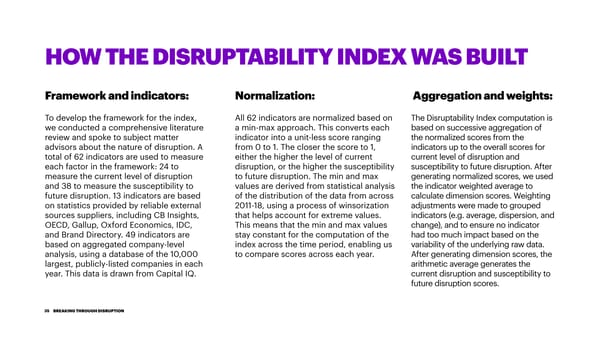HOW THE DISRUPTABILITY INDEX WAS BUILT Framework and indicators: Normalization: Aggregation and weights: To develop the framework for the index, All 62 indicators are normalized based on The Disruptability Index computation is we conducted a comprehensive literature a min-max approach. This converts each based on successive aggregation of review and spoke to subject matter indicator into a unit-less score ranging the normalized scores from the advisors about the nature of disruption. A from 0 to 1. The closer the score to 1, indicators up to the overall scores for total of 62 indicators are used to measure either the higher the level of current current level of disruption and each factor in the framework: 24 to disruption, or the higher the susceptibility susceptibility to future disruption. After measure the current level of disruption to future disruption. The min and max generating normalized scores, we used and 38 to measure the susceptibility to values are derived from statistical analysis the indicator weighted average to future disruption. 13 indicators are based of the distribution of the data from across calculate dimension scores. Weighting on statistics provided by reliable external 2011-18, using a process of winsorization adjustments were made to grouped sources suppliers, including CB Insights, that helps account for extreme values. indicators (e.g. average, dispersion, and OECD, Gallup, Oxford Economics, IDC, This means that the min and max values change), and to ensure no indicator and Brand Directory. 49 indicators are stay constant for the computation of the had too much impact based on the based on aggregated company-level index across the time period, enabling us variability of the underlying raw data. analysis, using a database of the 10,000 to compare scores across each year. After generating dimension scores, the largest, publicly-listed companies in each arithmetic average generates the year. This data is drawn from Capital IQ. current disruption and susceptibility to future disruption scores. 35 BREAKING THROUGH DISRUPTION
 Breaking Through Disruption Page 34 Page 36
Breaking Through Disruption Page 34 Page 36